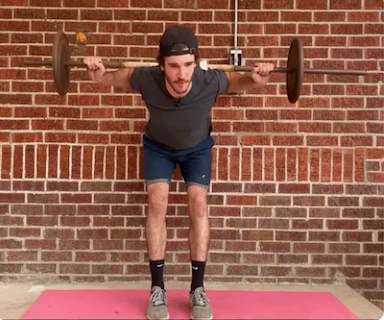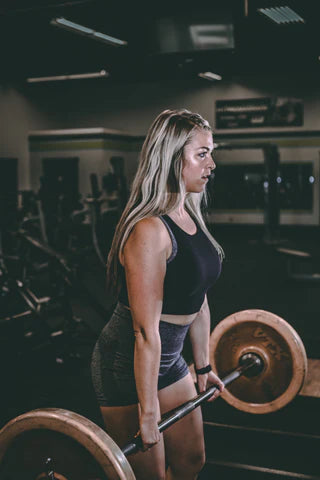
The rack pull has been said to be both useful and detrimental by many professionals.
Powerlifters and bodybuilders tend to prefer the exercise while therapists and chiropractors advise their patients to stay away from it.
In this article, I will be discussing both sides of the argument.
Read on to learn the benefits and downsides of the rack pull as well as 7 effective alternatives.
Why The Rack Pull?
The rack pull is infamous for being an accessory movement to the deadlift.
Considering the shorter range of motion throughout the lift, the rack pull mimics the last 50% of a deadlift. The rack pull exercise allows a lot of weight to be used with little movement.
Being a pulling/lifting exercise, the rack pull is beneficial to the posterior chain (when done properly).
If you're serious about increasing your deadlift, the rack pull is a good accessory lift. If you're a beginner and don't have much lifting experience, I recommend using a lighter weight or starting with a rack pull alternative.

Rack Pull muscles worked: Glutes, hamstrings, erector spinae (lower back), traps, upper back, core, and forearms.
Rack Pull How To Guide
Choose a comfortable weight that allows you to master the form of the rack pull before you test your body's true strength.
Place the barbell slightly below knee level. This is a very important step to help you complete the rack pull exercise with maximum efficiency while protecting yourself from injury.
Grip the bar outside your knees at a comfortable position. Before you start to lift the bar, make sure your head is up, spine is straight, and knees are pushing externally and not internally.
Activate your glutes, engage your core and lift the weight until you're fully vertical. (do not overextend - this can cause lower back injury)
Sustain good posture while squeezing your shoulder blades back.
Low the bar by slowly hinging at the hips and maintaining a neutral spine.
Repeat for a comfortable amount of reps.

https://gymvisual.com/animated-gifs/10203-smith-rack-pull.html
7 Rack Pull Alternatives
1. Smith Machine RDLs: The Smith machine RDL provides a set path for concentrating on hamstrings and glutes while reducing injury risk. The rack pull involves lifting a free barbell from knee height, which focuses on more complimentary back muscles.

While the smith machine provides a set path and is great for beginners, the rack pull improves general back strength through a more natural action.
2. Good Morning Exercise: Involves a barbell across the lifter's upper back. It's a higher risk movement which is why lighter weight and a slow and controlled tempo is so encouraged. But, when done properly, the good morning exercise is one of the most effective low back and hamstring strengthening exercises out there.

3. Glute Hyperextension: Targets the hamstrings, glutes, and lower back. It involves a bench or machine where you can secure your feet, then lift the torso up while contracting the glutes and hamstrings.

4. Reverse Hyperextension: The reverse hyperextension is great for building the upper glutes and bulletproofing the lower back. It is not a weight bearing exercise which is great for spinal protection.
The exercise starts by laying flat down on a reverse hyper machine with your feet hanging off the edge, then lifting the legs up while contracting the glutes and lower back muscles.

5. Glute Focused RDL: Glute RDLs use the power of the hip hinge to develop the glutes, lower back, and hamstrings. If your looking to grow/strengthen your upper buttock, glute foused rdls are a great option.
As you lower the weight, focus on your glutes to propel your hips forward and back to the starting position. With enough weight and proper form you should feel a strain on the upper buttocks.

6. Hip Thrust: The hip thrust is a popular exercise for targeting the glutes and building a strong posterior chain. The exercises involves sitting on the floor with your back against a bench or box, then placing a barbell or dumbbell over the hips and lifting them up, and squeezing the glutes. An awesome variation of the hip thrust is the kas glute bridge.

7. Back Extension: The last exercise is one of my favorite lower back rack pull alternatives. The back extension is a simple but effective exercise for targeting lower back muscles. Similar to glute hyperextension, you lock your feet into a machine and lift your torso. If bodyweight is too easy, try grabbing a plate or dumbbell.
FAQ
What is an appropriate weight for Rack Pulls?
If you're just starting out, start with a lighter weight (about 30-70% of your body weight) to focus on form. If you consider yourself an experienced lifter, you probably know what weight you're comfortable with (100+% of your one rep deadlift max).
Why do rack pulls hurt my back?
If you feel pain in your back during rack pulls, it may indicate poor lifting form or weak core/surrounding spinal muscles, such as the quadratus lumborum.
To reduce back discomfort, keep a neutral spine, tight core, and engaged glutes throughout the workout. That said, rack pulls are not the most "lower back friendly" exercise out there and there are plenty of safer alternatives.
When should I visit a chiropractor or pt for my lower back pain?
The standard rule of thumb is that if you are in severe pain and at-home therapies are ineffective. Also, if you have cause believe the problem originates from the spine. Lower back discomfort is subjective, which makes it difficult to assess. A tiny bit of controllable pain is normal and may often be treated at home, but if you are in severe pain, listen to your body and consult with a specialist.
Low Back Strengthening And Relief
A downside of the rack pull and some rack pull alternatives are the strain the exercise places on the lower back. When heavyweight is involved, exercises like the deadlift and rack pull are detrimental to the lower back. If you injure your lower back through lifting, deep-tissue massage is a great way to help reduce tension and relieve pain.
To do this you are going to want to apply targeted, effective deep-tissue massage to a few lower back and upper glute muscles (QL, spinal erectors, and Gluteus Medius). This can be done by a trained physical or massage therapist, but I highly recommend using a purposefully made tool on your own time like the QL Claw. The QL Claw was designed specifically to relieve muscle-induced lower back pain in cases like this.

More Rack Pull Alternatives
If you are looking to build lower back strength in a safer and less stressful way than the rack pull or rack pull alternatives, check out my Back Of Steel Strengthening Program. This program includes exact exercises that helped me create a bulletproof lower back that has been healthy ever since my prior pain.

[1] Donnelly, Joseph M. Travell, Simons & Simons Myofascial Pain and Dysfunction: the Trigger Point Manual. 3rd ed., Wolters Kluwer Health, 2019.
[2] Davies, Clair, and Amber Davies. The Trigger Point Therapy Workbook: Your Self-Treatment Guide for Pain Relief. 3rd ed., New Harbinger Publications, Inc., 2013.


